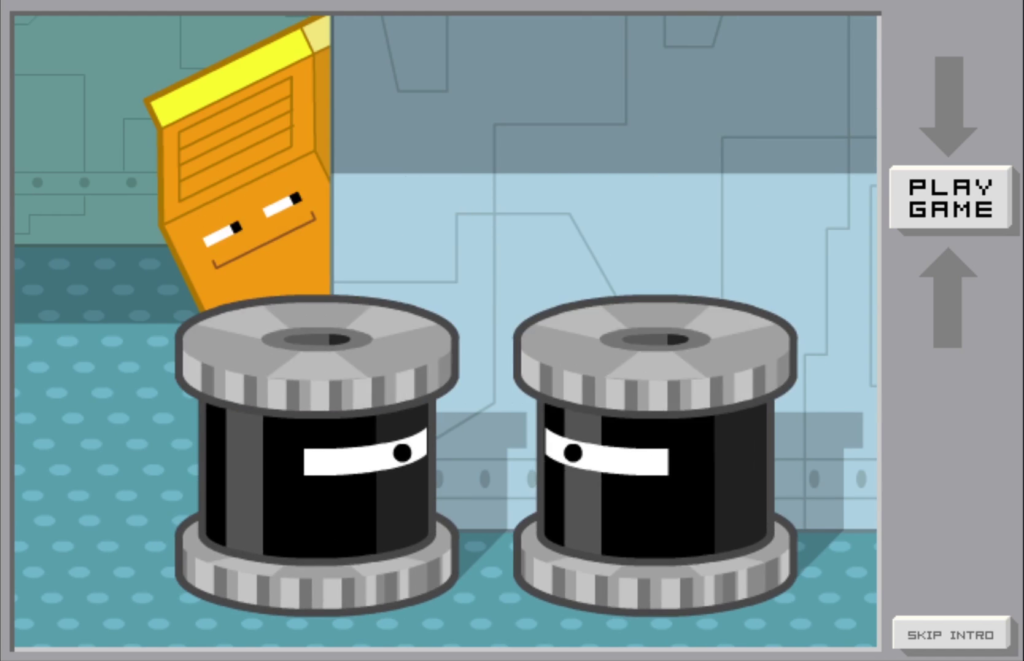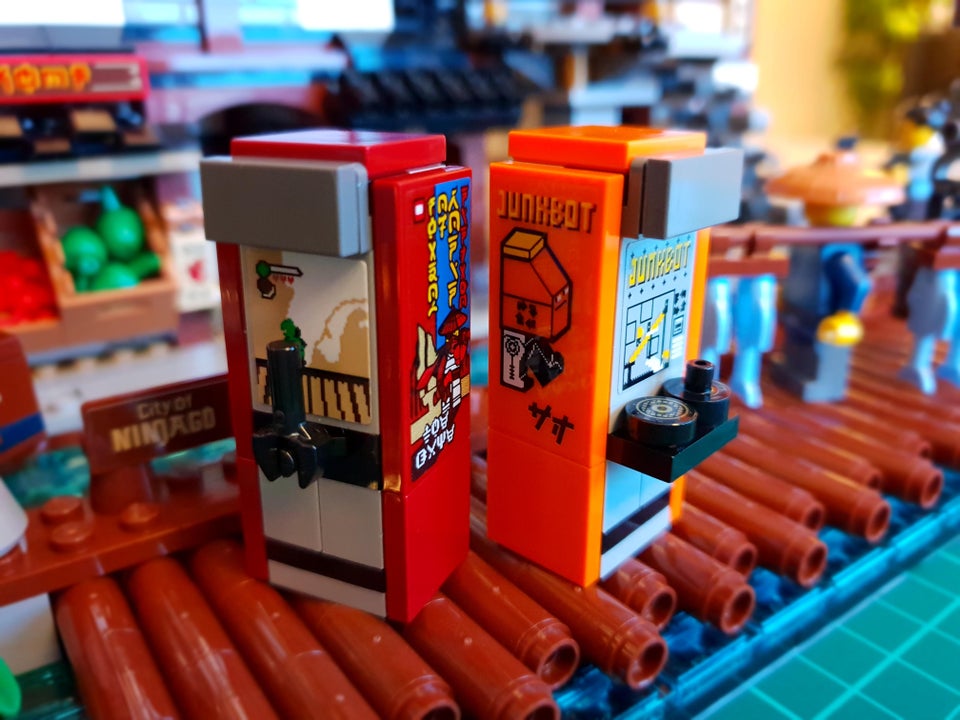
Junkbot (2001) and Junkbot Undercover (2003?) are—or were—puzzle games on lego.com, two of that website’s numerous free Flash games to which I dedicated many hours of my childhood. They were early titles from Gamelab, the since defunct developer that later released the original Diner Dash. As simple as they appear to be, Junkbot and Junkbot Undercover played an outsized part in my creative development. In particular, I owe the art directors Peter Lee and Frank Lantz for the gray, grungy factories full of dripping pipes, computer consoles, and signs reading “no access,” as well as Junkbot’s hilarious deadpan expression and shifty eyes. When I first began writing stories as a child, my material initially derived from Junkbot. This is the origin of the “Junk-Robo” character in the Two Paper Wads series I have privately been working on. In recognition of what I owe the Junkbot duology, I want to honor the working-class robot with this writeup.
(Update: I adapted and expanded this post into a video essay on my YouTube channel! Please consider checking it out if you would enjoy this sort of thing.)
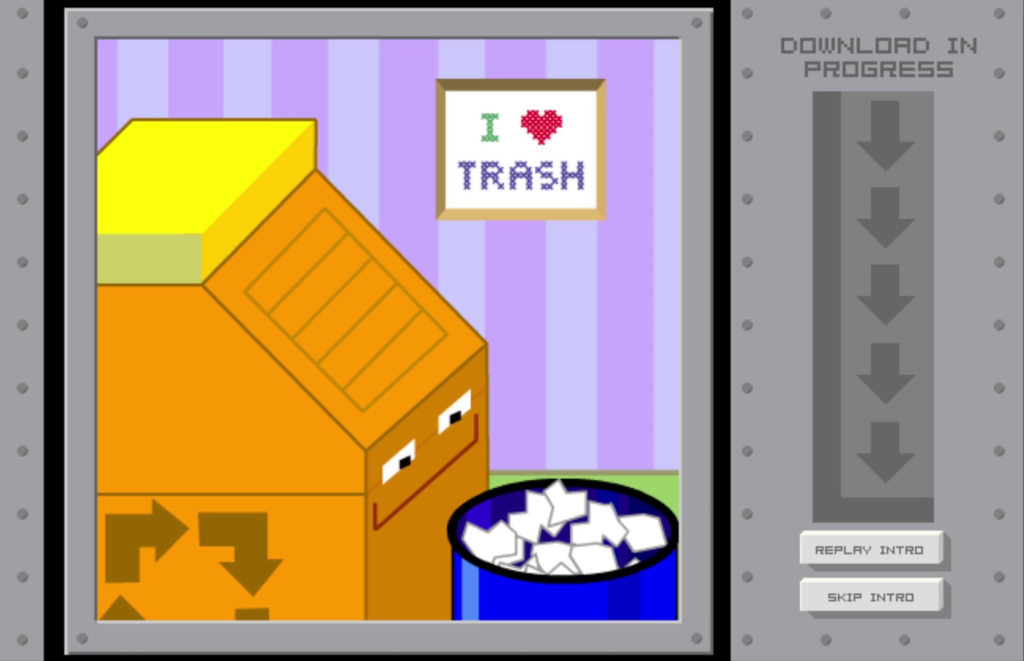

Junkbot opens on the titular bot, in a quaint cottage complete with a framed needlepoint reading “I LOVE TRASH” hanging on purple wallpaper, becoming worried when he runs out of junk to dump down the literal hatch on his dumpster-like head. Browsing a help wanted section of a newspaper, Junkbot finds a janitorial position at a factory. The job involves walking room to room and eating recycling bins exclusively filled with paper wads. Bossbot, a totally inhuman Eyebot absurd in a necktie, gives him his assignment in a letter striped green-and-white like the output of an old dot matrix printer, and the game begins.
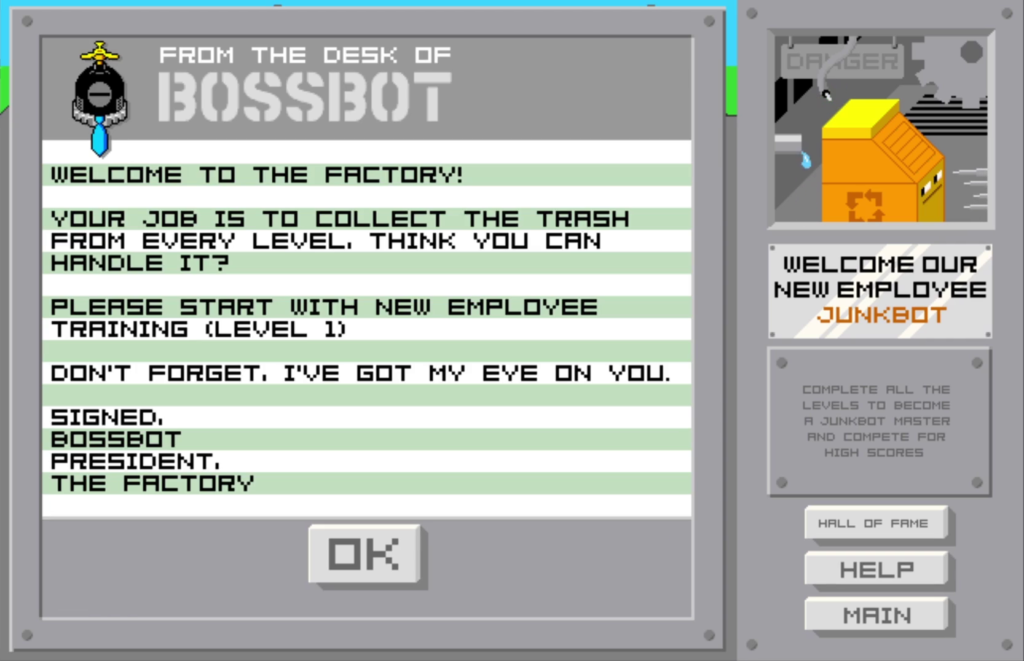
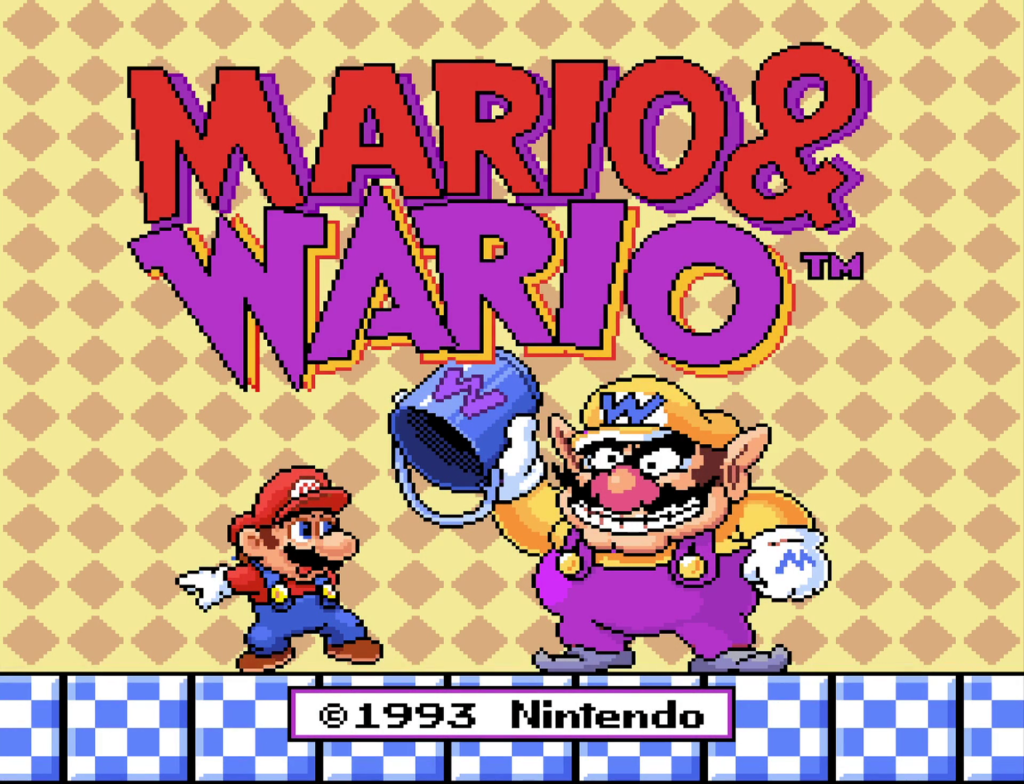
Each level is a single screen, completed when Junkbot reaches every blue trashcan and crushes the bin into his head. He might somehow recycle them, judging from the emblem on his side. The player does not control Junkbot, who marches forward until he bumps into a barrier or pit, at which point he pivots with a satisfying squeak to march in the opposite direction. Junkbot can climb one brick at a time (i.e. staircases) and cross gaps one stud wide. This concept has precedents in Lemmings (1991) and even something more obscure like Game Freak’s Mario & Wario (1993). But those games offer pretexts for their main characters’ helplessness: the misconception of lemmings as suicidally oblivious migrators and the bucket Wario crams over Mario’s head. What’s Junkbot’s excuse? Beats me. Just asking the tough questions.
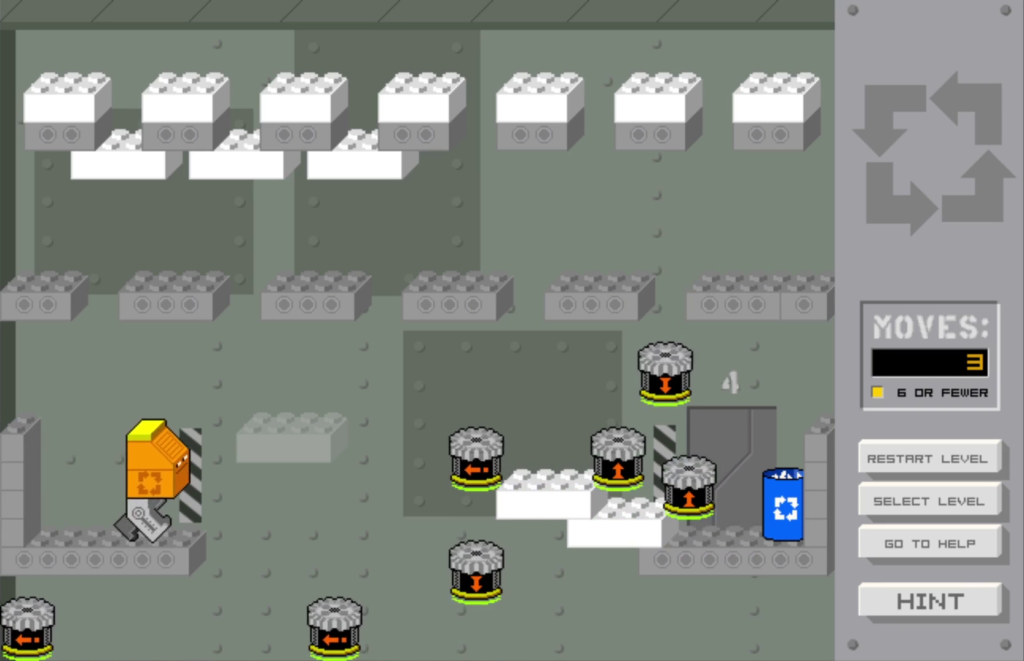
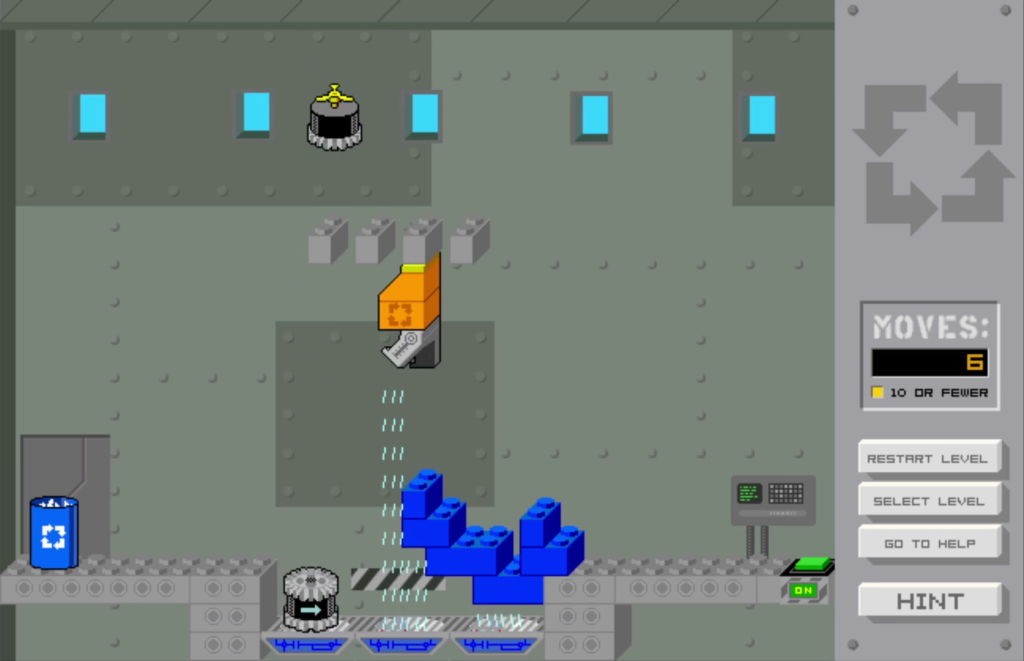
Junkbot’s primary enemies are Gearbots and, later in the game, their kin the Climbbots, Flybots, and Eyebots, all of which follow simple movement patterns. Gearbots move side to side like Junkbot, though cannot clear even a one-stud gap. Climbbots move side to side but are capable of climbing four bricks’ height if they reach a wall. Flybots behave the same as Gearbots, except airborne. Eyebots break their patrols if Junkbot enters their line of sight, chasing the poor janitor until he is taken out or they ram into a barrier. Eyebots cannot move diagonally. Like every other obstacle, the Gearbots kill Junkbot in one hit, or at least cause him to lose his color and assume a dejected expression. As a child, the Eyebots frightened me, mainly due to the shrill ringing they emit if they spot Junkbot and, their namesake eye bright red, hunt him down. Level 4-7, featuring two Eyebots pinned in, is called “Don’t Let the Dogs Out”—so Gamelab knew the Eyebots behave like fierce guard animals waiting to pounce, their sharp-toothed mouths barking through the prison bars.

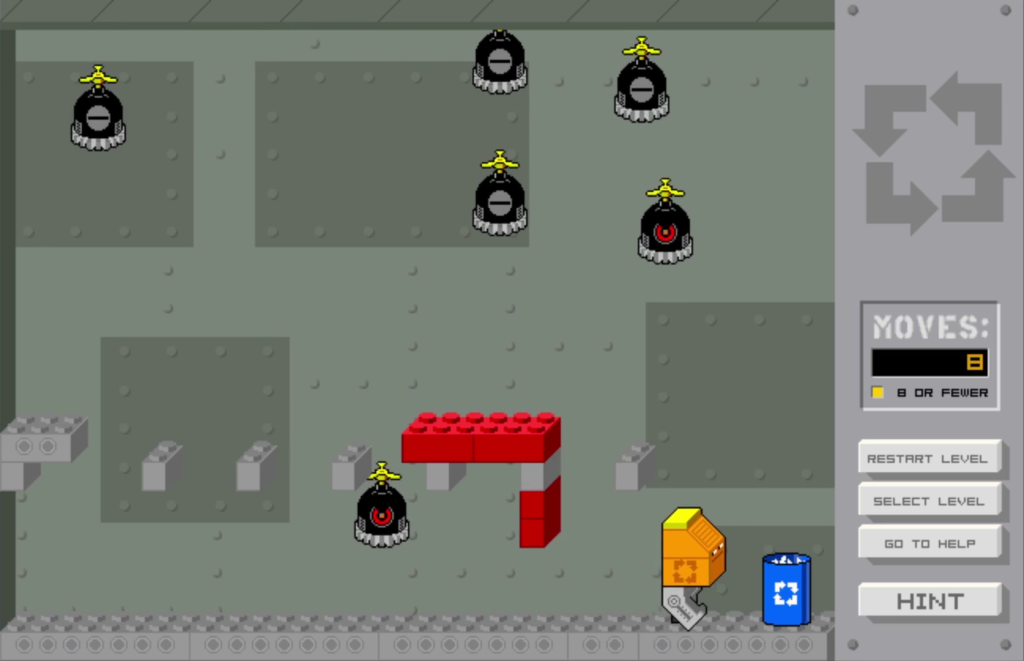
How can poor Junkbot survive his shift? Part of his strategy is a core aspect of Junkbot’s personality: he does not give a f***. (Censored because this is not an R-rated post.) Nothing fazes Junkbot, so he is not stressed out while performing janitorial duties. But he could not do it without the player. To help him survive and eat trash, we use the mouse cursor to move LEGO bricks, whose bright colors distinguish them from the otherwise gray and dark stages, to allow Junkbot to clear gaps and dodge obstacles. In addition to Gearbots, there are other environmental hazards, including dangerous heated grills, wind-tunnel-force fans that blow Junkbot into the air until he hits the ceiling or a brick, and moveable bounce pads that spring Junkbot about five studs forward. While blasted against the roof, Junkbot continues moving his legs at the same pace as ever. Like I said: Junkbot does not give a flip.
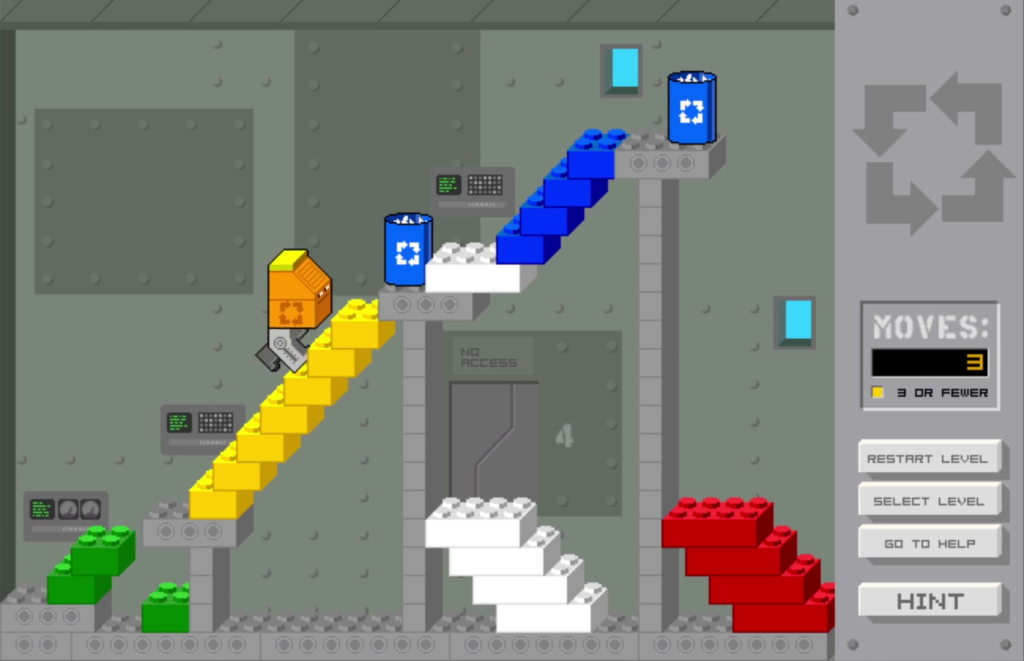
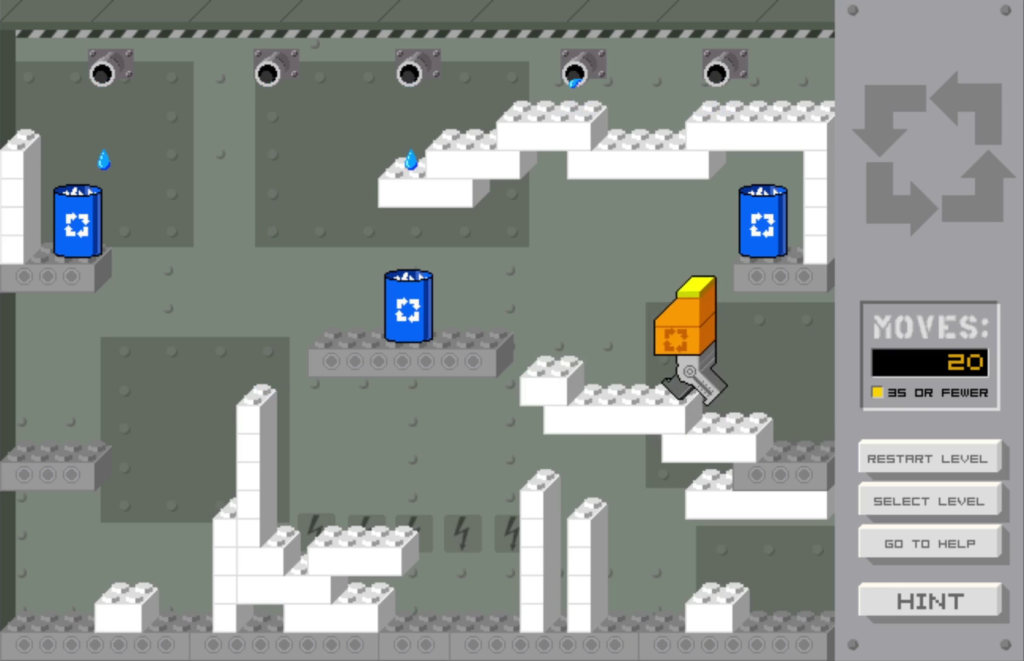
Junkbot is fair and consistent, as puzzles should be. If you lose, you’re not angry, because it’s your fault, not the game’s. The notable exception is level 4-12 “The Quest,” where the dripping water took out Junkbot on multiple attempts despite my having collected the armor. “Luck” and “puzzles” go together about as well as mustard and LEGO bricks, but this is clearly a mistake rather than a deliberate slight from Gamelab.
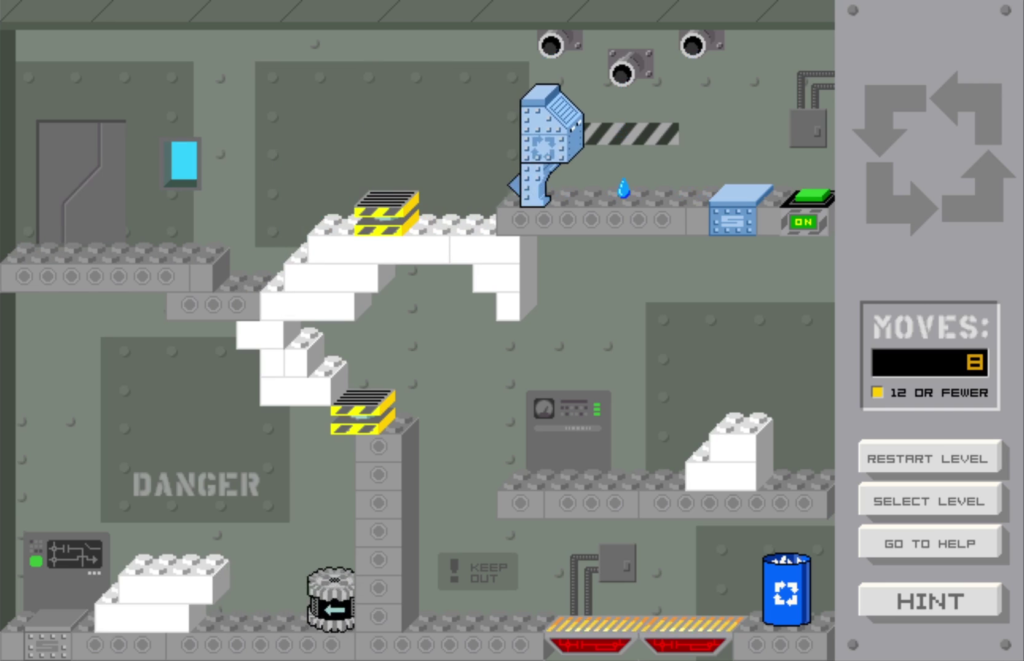
Each of the four buildings has fifteen levels, and each completed level awards a keycard. Once Junkbot attains ten keycards from one building, he can unlock the next. Building 4 shows a lock icon on the tenth keycard, the same as the previous three, but the player receives no reward for reaching this number. Junkbot has no ending, but I would call collecting ten Building 4 keycards the win-state.
For those players, like me, who want additional challenges for 100% completion, there are not only the twenty functionally extra levels. The player receives a Gold Award for clearing each level under a certain predetermined number of moves. While some Gold Award conditions offer wiggle room, others demand the player not waste a single click.
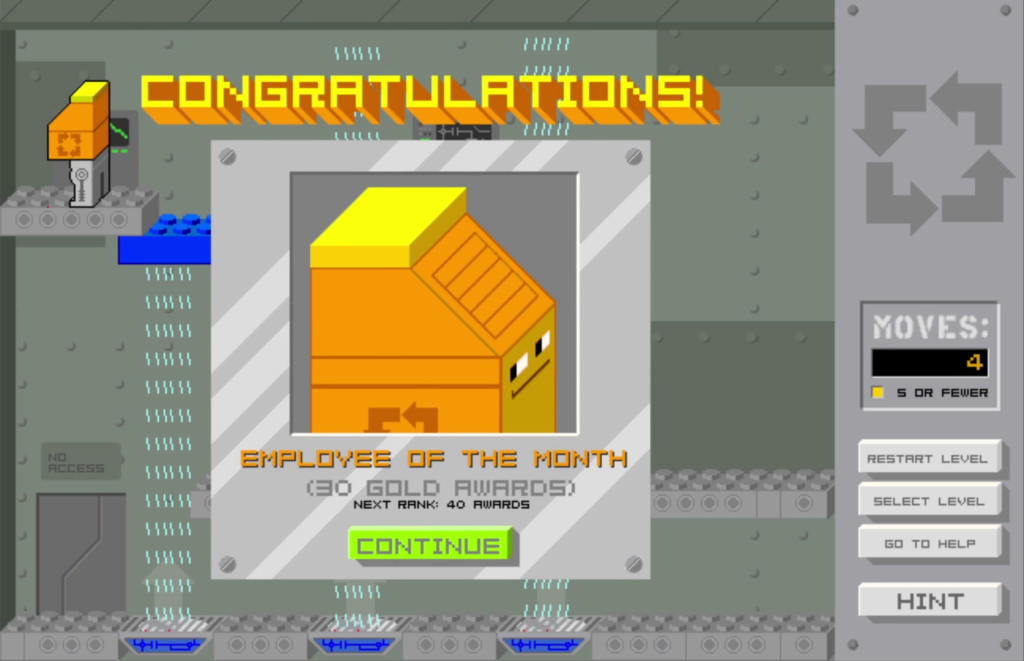
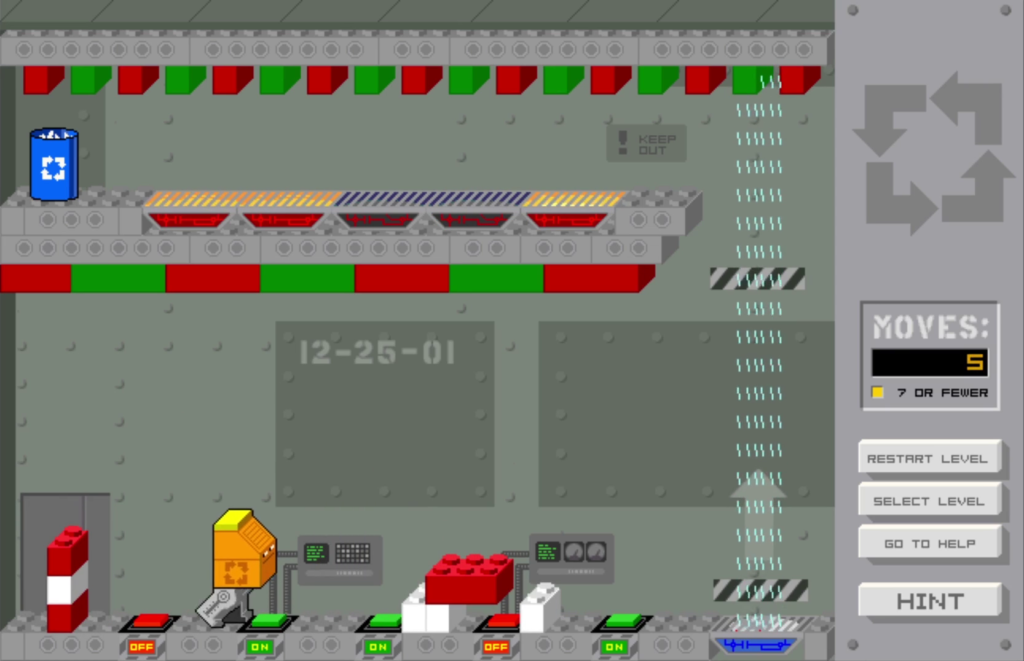
As the player does not need to complete every level, if they get stuck on any in particular, they can hop to another rather than have more fun gated off behind an insurmountable challenge. I appreciate a puzzle game that offers leeway, as, while hardly thrilling, some of the toughest video games there are fall into the puzzle genre. For the little kids who constituted the target demographic, it is a thoughtful touch. For an adult, not especially: Junkbot is by no means hard. Except for level 2-9 “Trapped in the Freezer.” Brrr.

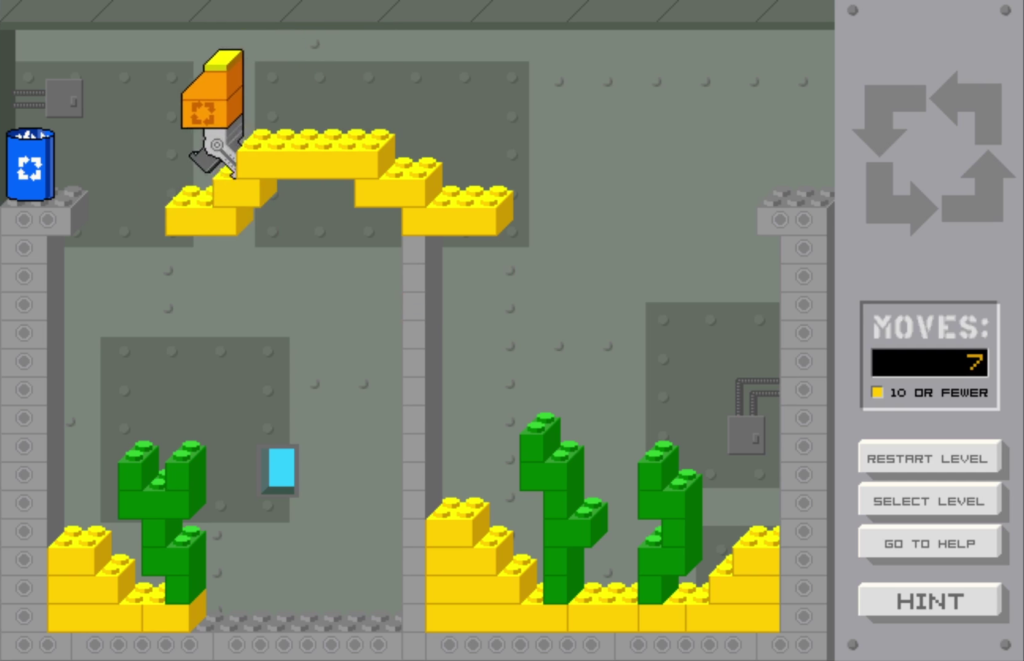
Like every other video game from my childhood I have returned to during “quarantine”—Pac-Man World (1999), Ms. Pac-Man Maze Madness (2000), SpongeBob SquarePants: Battle for Bikini Bottom (2003), etc.—Junkbot is a lot easier than I remembered it. A large number of the stages are not puzzles so much as tutorials. The opening four stages of sixty total, for example, purely allow the player to practice the point-and-click controls with zero risk and zero thought. The first time the game offers any challenge, with an ungainly brick layout complicating the Gold Award, is “Terrarium,” the seventh level of Building 1. Though there are no obstacles, achieving the Gold Award requires a degree of consideration. Even after Building 1, however, the game occasionally takes a break from challenge to demonstrate new mechanics, as in Building 3 level 1 “Portable Boost.” Despite these missed opportunities taking up about a whole sixth of Junkbot, these are excellent tutorials. Rather than interrupt the flow of play to force the player to read an explanation of the game mechanics, Gamelab sets up situations in which the player is likely to intuitively and safely discover them, or in at least one case incorporates the writing organically in the title of the level: “Don’t Touch the Gearbots.” If this method fails, the game also includes a written explanation in the “HELP” menu option.
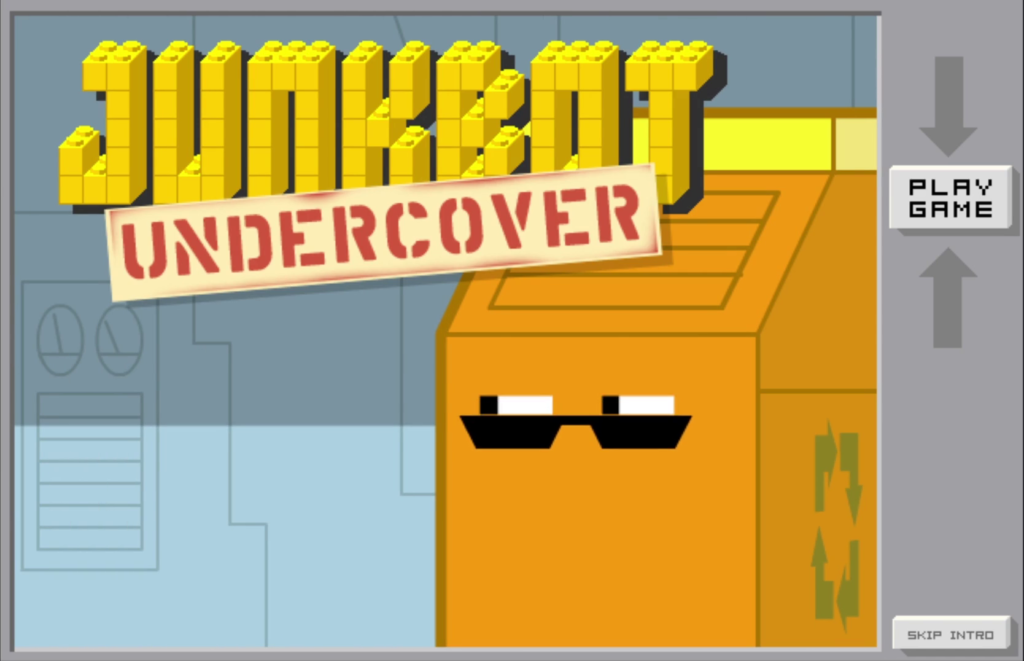
When I fired up Junkbot Undercover again, though, it was exactly as tough as I remember it! The darker levels and music, topped off with atmospheric water dripping and computer blooping sound effects, complement the higher challenge. It is a shame that Junkbot’s second outing seems less well-remembered than his first, as Undercover is the superior game. The folks at Gamelab already had Junkbot experience in their collective pockets and operated on the old-school video game ethos that if you’re playing the sequel, you’re great at the original. While by no means soul-crushingly hard like a really old-school computer game, Undercover definitely hews more difficult. I never beat it as a kid. If the player runs through each level in order, Undercover has, by level ten of sixty-one, introduced all the enemies and obstacles its predecessor offered in its entire sixty levels. Every mechanic is in the air from the get-go, and they never let up. Undercover resembles an expansion pack for the original, continuing where the first left off with Junkbot literally venturing into the basement of Building 4. Junkbot feels incomplete without the closure of Undercover’s further explorations of the game mechanics and conclusive ending. Yes, an actual ending this time.

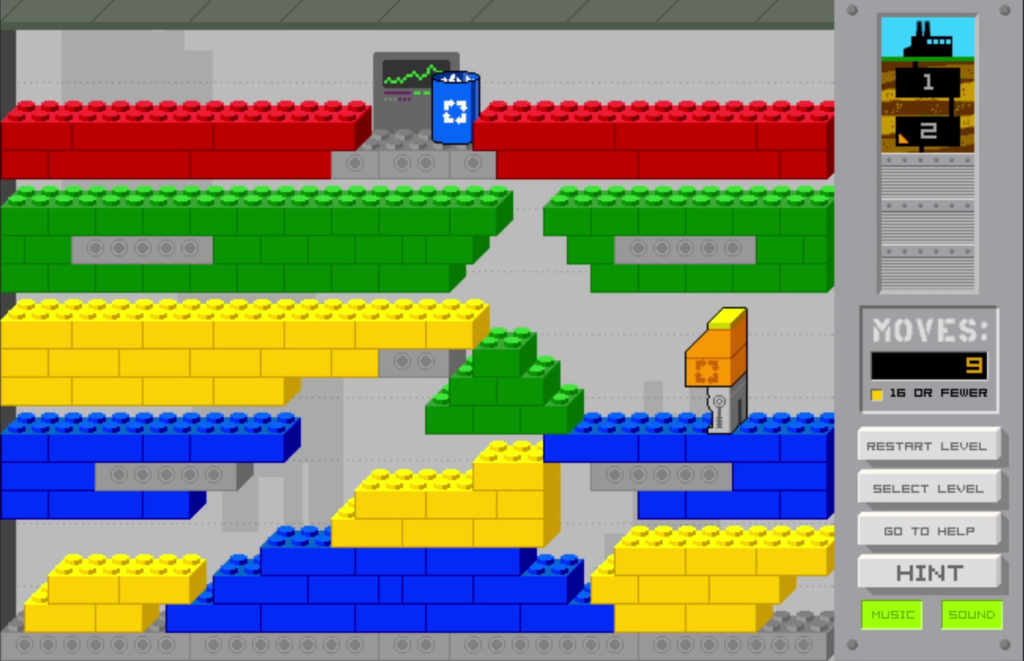
Building on this higher baseline complexity are Undercover’s new ideas, such as crates that Junkbot can push but on top of which the player cannot build and teleporters that warp Junkbot to other parts of the screen. The latter can be fiendish, too, forming the basis of the maze in level 3-7 “Quantum Roulette.” I might have named it Russian roulette, given the two teleporters that drop Junkbot into deadly lasers. Which are the lethal teleporters? The player can discover the answer only via trial-and-error. The Gold Award challenge caused parts of Undercover to bedevil even my adult self, with the aforementioned “Quantum Roulette” along with levels 3-6 “The Abandoned Coaster” and 4-5 “Central Database” taking me about forty minutes each. Not that you would know from the spritely jaunt in the videos I linked, from which I cut hours of failure.

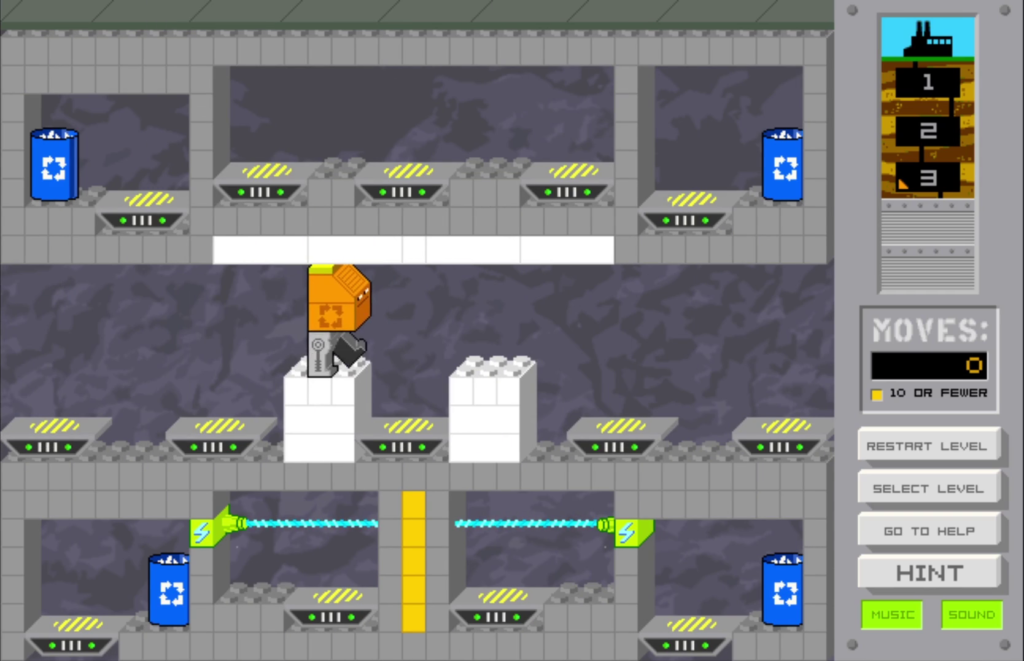
With the exception of levels 1-1, 1-2, 2-1, and probably some others that I forget, even Undercover’s introductory “tutorial” stages feature a higher degree of challenge. With 2-1 “Laser Lab,” the lack of difficulty feels like a missed opportunity, as level 2-12 “Return to Laser Lab” is nearly identical yet much trickier. Overall, Undercover is cleverer and more confident than the previous Junkbot adventure. The introductory cutscene is funnier, too, with somewhat more interesting animation.
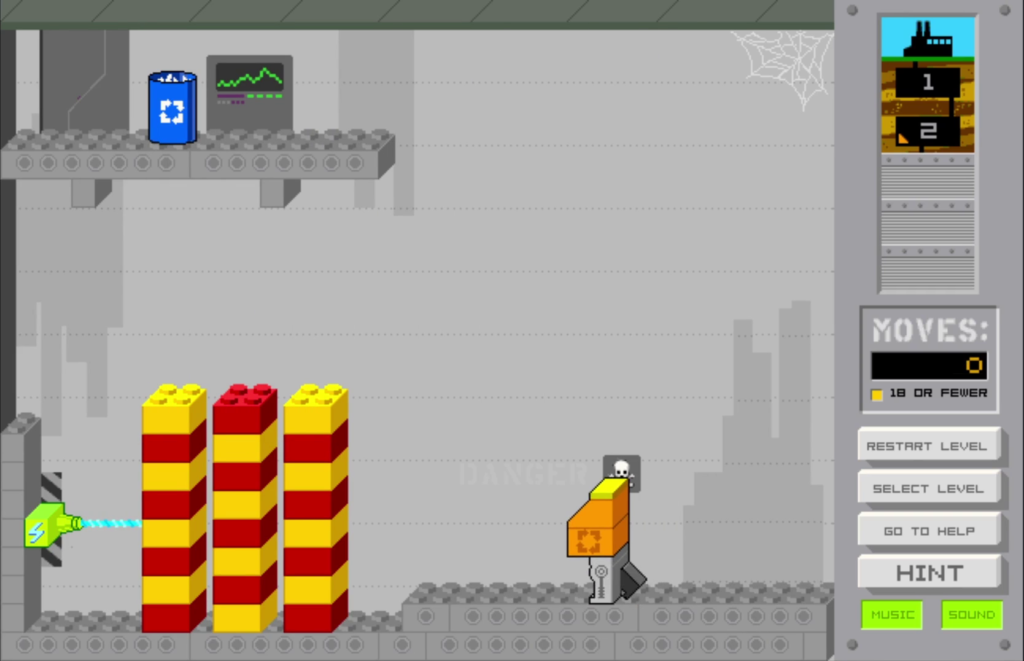
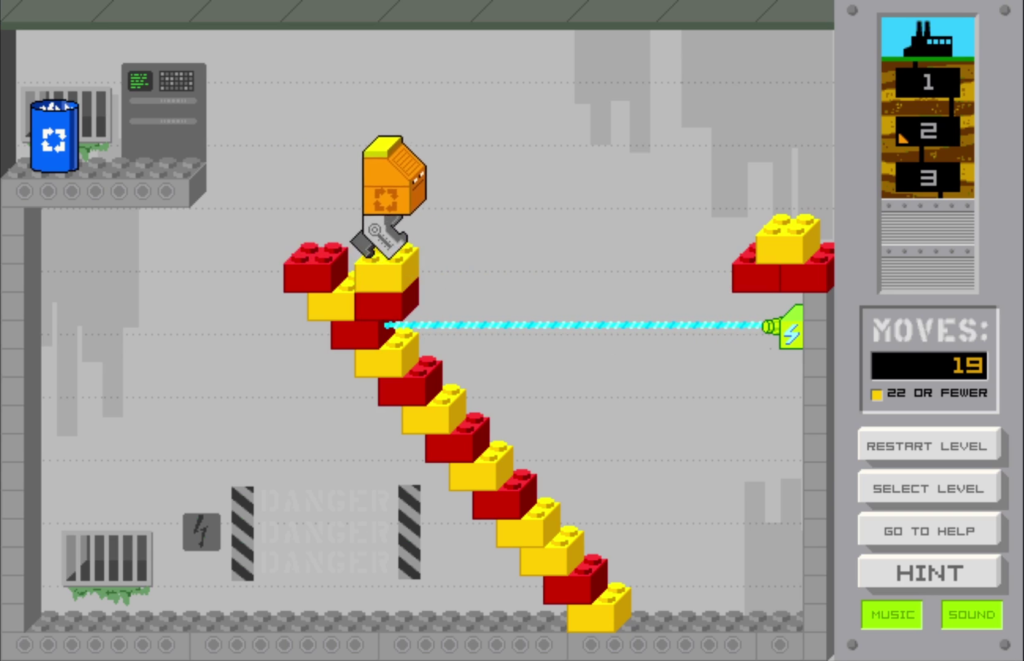
The plot this time is that Junkbot picks up a top-secret envelope the Gearbots drop. Labeled “PROJECT X,” inside he finds a scrap of paper that reads: “Don’t tell JunkBot about” before being torn off. (Is Junkbot’s name supposed to be capitalized in the middle?) Junkbot won’t take that lying down. Junkbot orders a “home spy kit” online to dig into the company’s secrets, accounting for Undercover’s goofy spy theme. Junkbot as a paranoiac is not a huge leap from his shifty eyes and tendency to always look behind him, as if over a nonexistent shoulder. The new letter from Bossbot does a poor job of allaying Junkbot’s concerns: “There are no secret underground areas, and I don’t want you sneaking into them!”
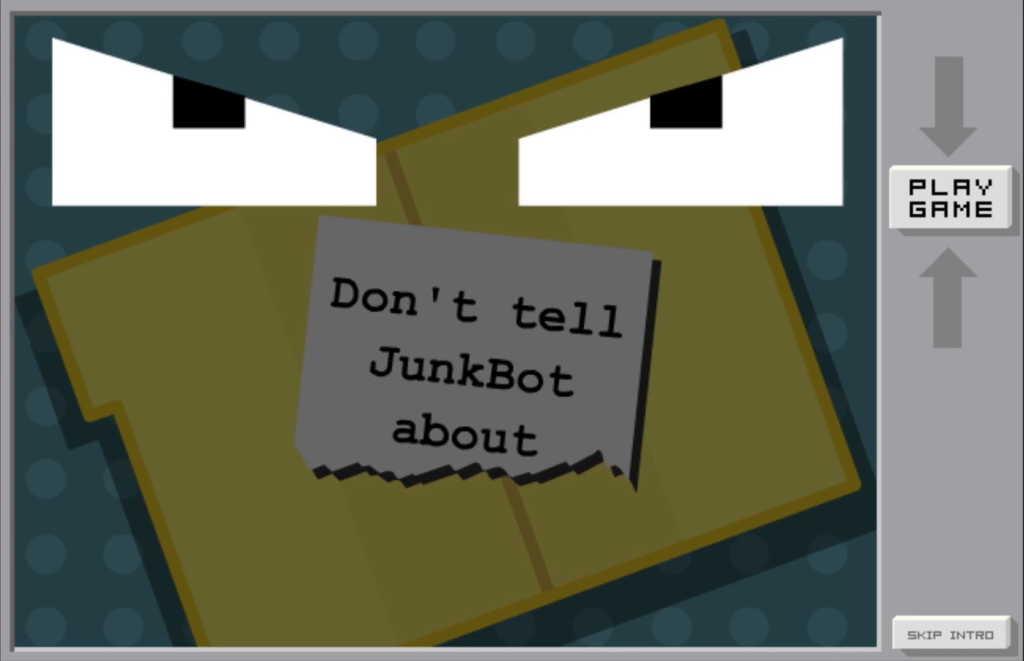
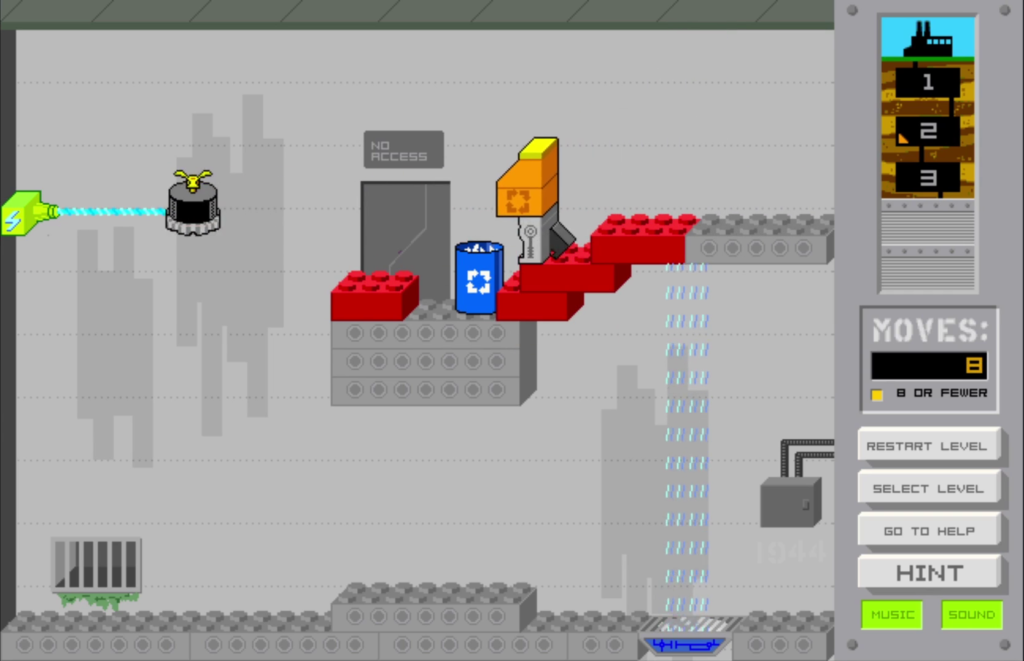
There is no further plot development until the ending, but based on the levels themselves, Junkbot ventures through subterranean factory floors, then into caverns full of cobwebs and mold. His descent closes in the spotless, white Secret Laboratory full of recycling bins animated with artificial intelligence. The AI trashcans can run, but they can’t hide. This is the other core component of Junkbot’s personality: he never gives up.
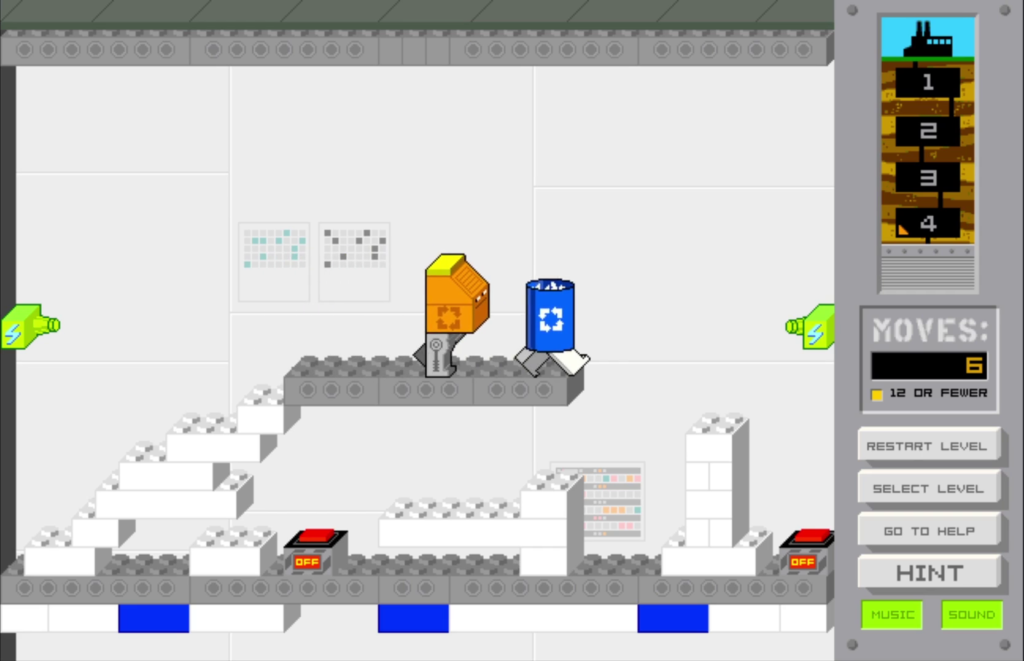
The darker level titles are a delight and suggest pulpy action: 1-6 “Elementary” (Sherlock Holmes?), 2-9 “Crawling through Vents,” 2-14 “The Chamber of Death,” 3-9 “Chase Scene,” 3-12 “The Incinerator,” 3-13 “Locked Room Mystery,” 4-2 “Mobile Suit” (Gundam?), 4-12 “The Reactor Core”… Crafting fiction based off these names might be a neat writing exercise. The twist comes in area 5: “Project X.”

The secret plan is apparently just a Climbbot and an Eyebot, though the level nonetheless proves hecking tricky. The end cutscene reveals that, instead of these two killer robots, the actual Project X is a surprise party for Junkbot. The Gearbots owe him that much, I suppose, for cleaning the buildings despite their efforts to kill him. But the camera zooms in on one Gearbot holding a folder marked “PROJECT Y,” transitioning to a question mark before dumping the player back to the menu. Undercover preserves some mystery in the world.
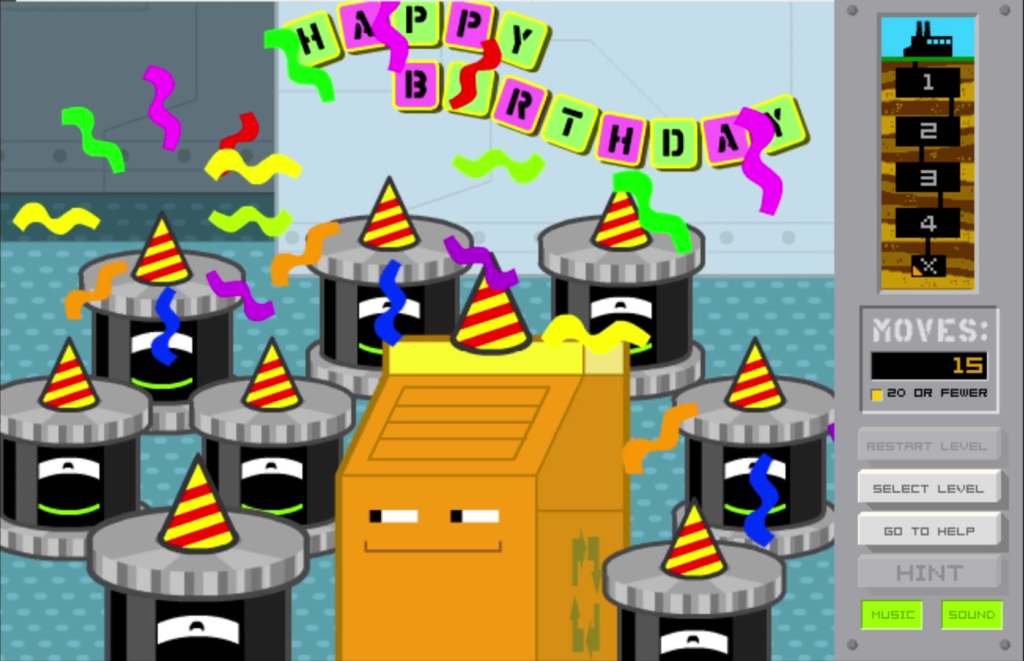
Want to know how to play Junkbot today?
My recommendation is BlueMaxima’s Flashpoint, a massive Flash preservation project with thousands of games and animations, including Junkbot and Junkbot Undercover. I suggest downloading Flashpoint Infinity, since the alternative, Flashpoint Ultimate, involves downloading all the Flash media simultaneously, demanding more than four hundred gigabytes of storage. Next, search “junkbot” in the Infinity search bar and click the Junkbot games’ icons to download and open them. Though I did not get Junkbot Undercover’s save feature to work. You can also find Crystalien Conflict, LEGO Studios Backlot, and pretty much any other online LEGO game in there too. Bonus! (Be warned, reader, if you let children access the program, that Flashpoint is dedicated to preserving all Flash content, including porn. There is an option to block “extreme” content.) You can find Flashpoint at this website: https://bluemaxima.org/flashpoint/
You can also play Junkbot off of Project Brick. Based on my experience, this method is tougher, so I would advise against it. However, the Project Brick archive includes a no-save version of the games that lets you access all levels from the get-go, so if you want that feature, feel free to seek them out. I am not sure which of their many archives contains Junkbot, though! You can find Project Brick here: http://biomediaproject.com/bmp/lmp/games/
Junkbot and I go way back
While there is no surprise in Junkbot and Junkbot Undercover being light on story, it is surprising that they do not tie into any LEGO theme. LEGO has never released a Junkbot kit. Unlike other old LEGO icons including Rock Raiders, Johnny Thunder, or, well, Luke Skywalker, Junkbot was not an established toy character. That, alone, would be enough to distinguish him among the LEGO Club games, but the simple yet fleshed-out gameplay and catchy music definitely helped. A lot of people still like Junkbot. For example, somebody called jxu on the website Rebrickable took the time to create a huge model of Junkbot in August of this year. You can find it here: https://rebrickable.com/mocs/MOC-50835/jxu/junkbot/#details
I bet that something like 100% of these Junkbot fans are people who played it as kids, the marching orange dumpster becoming the stuff of warm memories. “Nostalgia” apparently moves some people to tears, but not me. I do not remember childhood fondly. Still, Junkbot definitely falls into the “happy memory” bin. It speaks ill of the way our culture approaches technology that the only people keeping Junkbot and thousands of other Flash games alive are a few preservationists like the dedicated souls involved with BlueMaxima.
Obviously Junkbot and the vast majority of Flash games are not invaluable treasures. The average crappy novel probably contains more interesting ideas than the average crappy video game, and certainly than the average crappy Flash game. But even a crappy Flash game is art, and the fact that so much video game art survives only through piracy and dubiously legal fan archivists is a tragedy indicting the whole copyright and technological systems that chain us up. How many people are there whose day would really be brightened up with a round of the game they loved as a kid, but who do not have the time or knowledge to seek out this media that LEGO thoughtlessly deleted, perhaps had to delete? In the words of the enigmatic BlueMaxima, when asked if Flashpoint is legal: “The only real answer is nobody knows and really, nobody should care. Games that more or less have a ticking clock until they die need to be saved now, as fast as possible.” Damn straight. Pop cultural ephemera like Junkbot have value. Not as much as the writings of Jamaica Kincaid, granted, but still value. It’s not like we can only have one or the other.
Many other video games I played in my early childhood affected my ways of thinking and artistic sensibilities. What sets Junkbot apart is the degree to which it affected me. Junkbot-related fiction is not the first I produced as a little kid, but my most robust series of the time, the characters that I returned to the most, certainly were. I began by drawing pictures of Junkbot engaging in various activities and eventually wrote a little book called “Two Happy Trash Wads” that starred two living paper wads who used a string to escape their trashcan when Junkbot picked it up to process as in the game. After that, I wrote dozens and dozens of wordless books about these two characters, expanding the world they lived in to slapstick life. Though the robot himself rapidly became a minor character, I never forgot about where it all began. This was also the reason I attempted to make many characters resemble LEGO minifigures. If asked, I would have suggested playing Junkbot and Junkbot Undercover as a necessary primer for my books. Given the early stage of my artistic output these stories constitute, Junkbot is, unlikely as it sounds, foundational to my writing.

On one level, it is a case of whatever I happen to have been exposed to influencing the putty-like mind of little kid me. But I think there is something to Junkbot. After all, SpongeBob SquarePants: Battle for Bikini Bottom might have been a top-notch platformer, but I did not write a single book based on it. Or rather, I did, but it was my spin on the premise “villain’s robot army gets out of his control” rather than borrowing the characters or any specifics. The minimal storytelling of Junkbot unintentionally opens ample space for creativity. I like to imagine that Junkbot is some kind of junky (fittingly enough) seeking his next trash fix, and his monomania leads this lowly janitor to unintentionally take over the company, represented in his title of “Our New President” if the player attains all Gold Awards in the original. This ending must be non-canon, since Bossbot remains the President in Undercover, but that is neither here nor there.
What is the player’s role in the game’s universe, if we do not control and hence are not Junkbot? Does Junkbot move bricks on the fly with telekinesis? After all, it is Junkbot who receives the company and home spy kit rewards, not the player, despite the fact that Junkbot apparently paces back and forth instead of doing any work.
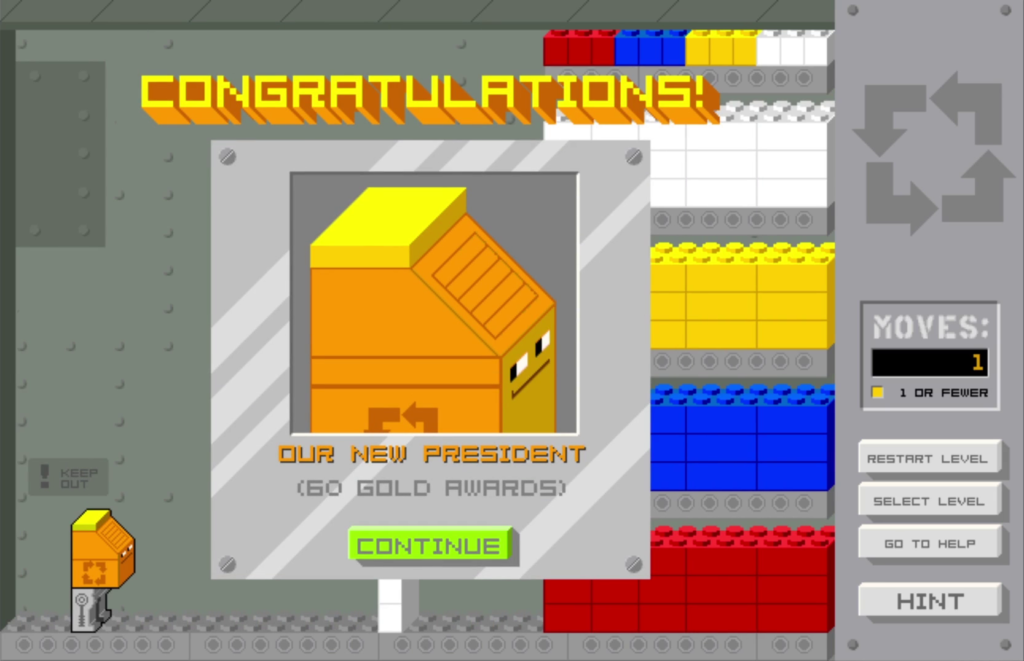
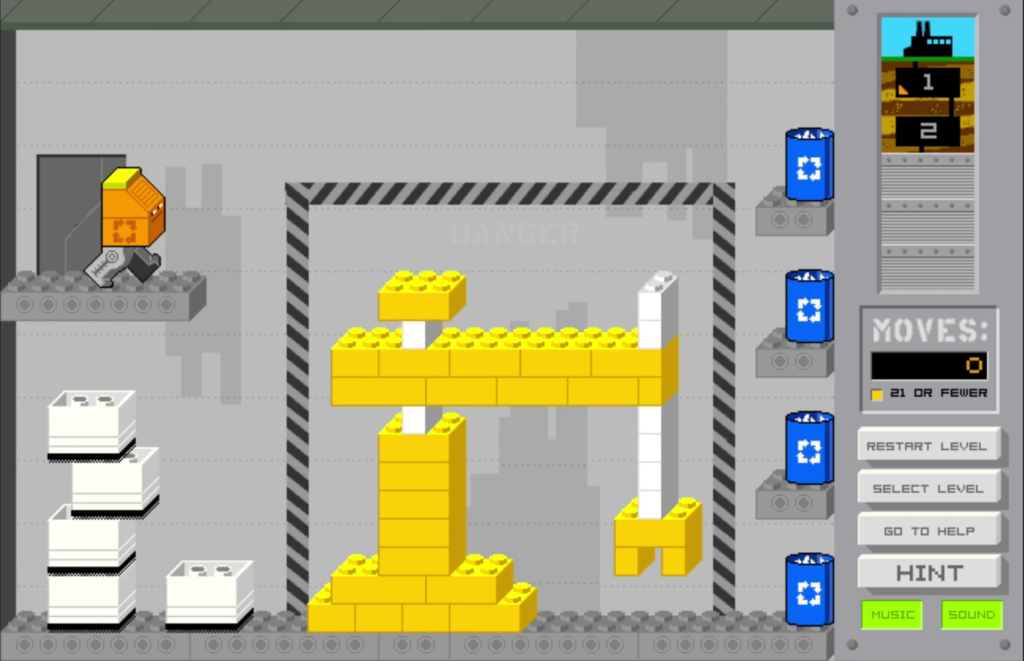
As a kid, I wondered what this company that hired Junkbot actually does. I assumed the buildings are factories because Bossbot’s memo opens with: “Welcome to the factory!” However, there is no sign of manufacturing beyond the smokestacks on Buildings 1 and 4 and horrors like the giant green-skinned monster of Building 3’s secret laboratory, level 3-15. No room Junkbot traverses contains industrial equipment except Junkbot Undercover level 1-13 “Trash Picker,” and that is debatable: The trash picker not only might be fake—a crane made of moveable LEGO bricks—but would clearly move trash, not product. Where is all the trash coming from? Most likely, the factory manufactures Gearbots. But for what purpose? Why let them run loose through the facility? Why do many rooms seem to lack an entrance or exit? So many aspects of the setting still get my brain gears spinning, imagining an alien industrial world where single-minded weirdos like Junkbot feel at home.
Whether or not Project X is merely a surprise party, the factory is undeniably involved in shady dealings. Junkbot legitimately found secret underground labs full of experimental laser and teleportation technology. The original Junkbot’s level 4-8 is called “What Is Project X?” and features two vaguely humanoid figures made of bricks. Was Junkbot’s surprise party a coverup to get him off Bossbot’s tracks? Is Project X a ploy to create life, after all? The artificial intelligence project Junkbot uncovers in the Secret Lab area is less notable, given that every character is already an AI.
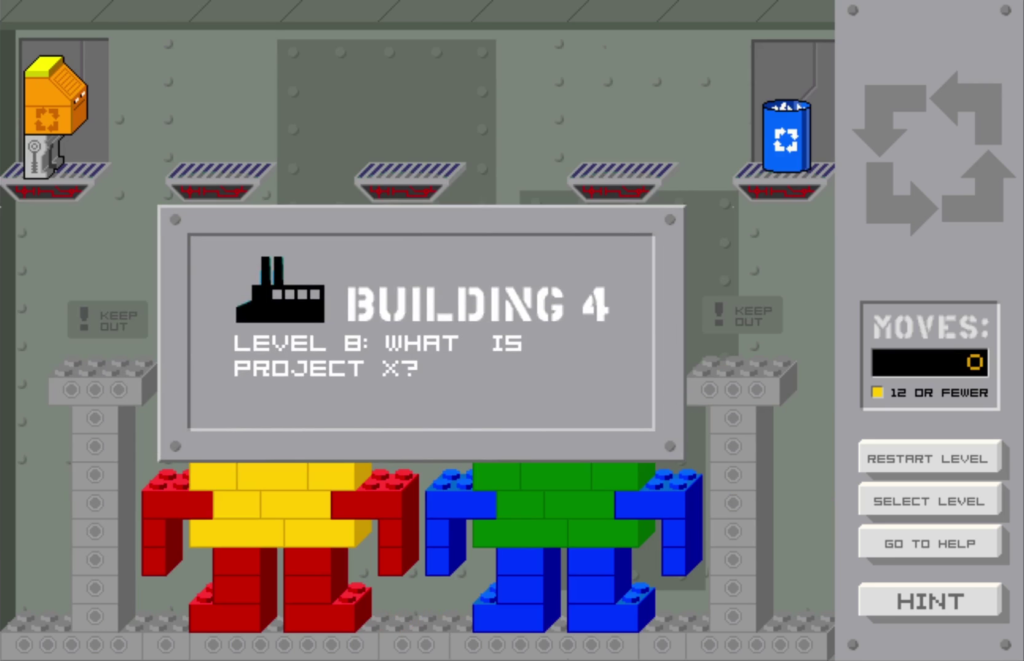
This leads me to another question: who built the robots to begin with? What exists outside the factory? The world of flat, green plains Junkbot depicts surrounding the four dark buildings of traps and robots might have inspired me, as a kid, to make the world of my stories much the same: vast, grassy wilderness with the occasional industrial complex. Not noticing the Bossbot character, I intended one of my more serious recurring villains to be the owner of these factories, intuiting that they must be some kind of weapons manufacturing plant. While I doubt anyone but me totally understood these nuances of my silly stories, the enthusiasm and creativity simple little Junkbot drew out of me is undeniable. It is a cliché, but experience leads adults to really lose something of the wonder that children can find in random stuff. As a grownup, I have no idea how I could have spent so many hours and so much thought on video games that I can now clear in a day. But I am glad I spent that time doing something I enjoyed. Not like a little kid had much better to do, anyway.
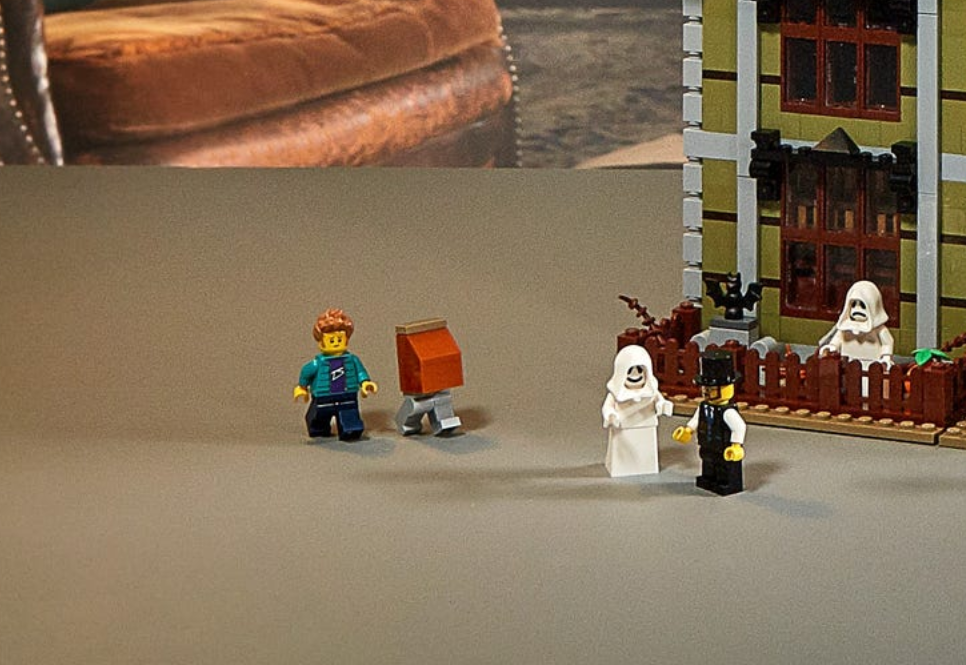
People talk a lot about nostalgia these days, typically in the context of corporations cynically wielding it to sell stuff to people burnt-out on adulthood hell. LEGO might have hopped into the nostalgia bandwagon too, hiding a blank Junkbot in the 2020 set 10273 Haunted House alongside other early-2000s LEGO references. Junkbot, according to the instruction booklet, is disassembled and in storage in the Manor von Barron’s attic. The colors are dulled, as though Junkbot, after being shut down and tossed in a crate, was left to rust.
Full disclosure: I used to be a big LEGO fan. Shocking! Even as a kid, I thought that LEGO lost something when they pivoted their emphasis to licensed themes—Star Wars, Indiana Jones, Marvel, Mario, Minecraft, and who knows what else by this point—instead of their original settings, though those were also rooted in pop culture properties. The early Space sets were based on Star Trek, Johnny Thunder on Indiana Jones, and so on. Screw Captain Jack Sparrow—I want Captain Roger Redbeard! Another instance of the corporate takeover of culture that stifles and homogenizes every aspect of life.

Junkbot’s status as disassembled garbage, as the junk he was named for, parallels the present condition of Johnny Thunder and those other LEGO originals. But that might be nostalgia speaking after all: LEGO was always itself a corporation out to hook me and many thousands on little bits of plastic. Star Wars remained the most popular LEGO mainstay through my childhood. Maybe Junkbot stood out because it was not trying to sell me anything: no tie-in toys, no ads, and none of the cynical psychological manipulation, gambling, microtransaction rubbish that plagues online games nowadays—just one-hundred twenty-one free, fun puzzles with catchy music. In a way, lego.com invited me to play and build new creations with their setting in the same manner as the pieces of the LEGO Group’s sets. Through some weird causal chain, Junkbot might have led to me becoming the sort who would write a detailed post about an obscure freeware Flash game.
